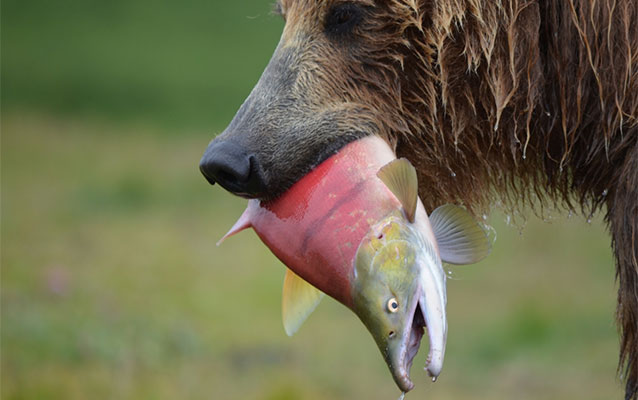Last updated: April 23, 2019
Lesson Plan
How Many Salmon Are Enough?

- Grade Level:
- High School: Ninth Grade through Twelfth Grade
- Subject:
- Literacy and Language Arts,Math,Science,Social Studies
- Lesson Duration:
- 90 Minutes
- Additional Standards:
- NGSS HS-LS2: Use mathematical representations to support and revise explanations based on evidence about factors affecting biodiversity and populations in ecosystems of different scales
CCSS.MATH.CONTENT.HSS.IC.A.1, .HSS.IC.B.3, .HSS.IC.B.4, .HSS.IC.B.6
Essential Question
How many Salmon are Enough Salmon?
Objective
Students will be able to calculate rates of escapement of salmon and draw conclusions based on population trends.
Students will be able to compare different sets of data based on graphs.
Students will be able to explain the importance of maintaining a balance in the environment and show the importance of individuals within an ecosystem.
Background
Lake Clark National Park and Preserve is a major spawning ground for the sockeye salmon. Park biologists study salmon populations in the Newhalen River.
Over thirty years of data from that study helps us understand the reasons salmon are so important to Alaska's ecosystem. This lesson allows students to relate to the ecosystem in which these salmon live. In the process, this lesson ties into a study of human impacts on the natural world, as well as the idea of resource management.
This lesson will take several periods to complete, with additional out of class time required to work on an assessment piece. It is a cross-curricular activity that ties in math, history, and science. Students will create graphs, analyze trends, and make calculations based on data. Students will analyze raw and studied data from the Newhalen River and other rivers or bays to determine trends and the effects of changes to environments. They will also conduct research to find historical data, which they will analyze to identify trends. The lesson can be altered to accommodate the level of the students, the focus of the class, and the area of study.
Preparation
-
Student Activity Guide
An activity guide for students to complete during the "How Many Salmon Are Enough?" lesson, with an introduction from the park. Download
-
Alaskan Salmon Presentation
Use this presentation to kick off your class exploration of our lesson, "How Many Salmon Are Enough?Download
-
Salmon Identification Video
Check out this underwater video that helps identify the differences between salmon species, and gives an idea of how fish counting works. Download
-
Daily Salmon Counts
Data for daily counts of salmon escapement on the Newhalen River, 1980 and 2014. Download
-
Newhalen River Escapement
Escapement data for ten years on the Newhalen River. Download
-
Telaquana vs. Newhalen
Data for fish counts on the Telaquana and Newhalen Rivers Download
Materials
Download Salmon Activity Guide
Download Salmon Telaquana vs. Newhalen
Procedure
- Step 1
Introduce this topic with your class by watching the salmon identification video (about 8 minutes long)
- Step 2
Discuss the importance of salmon in culture and the ecosystem. Take 10 minutes to have students relate the concept of salmon in Alaskan culture to something they find important to their culture. Ask students questions about ecosystems, interdependent relationships, resilience, and monitoring resources to gather students understanding and background knowledge.
- Step 3
Have students take notes as you lead them through the salmon presentation and the companion film "The Count". Take time to quiz students on the concepts and key terms before going through the information. While presenting, discuss the concepts as they relate to your classroom and ideas you have been teaching. Explain how to understand a trend graph and how to interpret that data that is presented. Discuss the importance of maintaining a balanced natural system and preventing destruction of wild habitats. (30-40 minutes)
- Step 1
Refresh student knowledge with a quick question and answer session based on the information from day 1. (5-10 min)
- Step 2
Hand out the student activity guide. Work through the first few questions together on the biology questions. Then, help students understand salmon escapement information and begin graphing. Allow students to work through the rest of the problems on their own. (1-2 class periods)
Use the lesson assessment (in the student activity guide) and the various fish data sheets from the materials section (above) and allow the students to work through the assessment. Be sure to hand out graph paper if the students are not making their graphs digitally.
Vocabulary
salmon, ecosystem, ecology, Trends, graphing, Data, Statistics
Assessment Materials
Students should use the information from Telaquana Weir escapement project and analyze it for trends. Students will show graphs, their reasons for decisions on the trends, and a comparison to the Newhalen River information they have already analyzed.
Additional Resources
Salmon are one of the most vital resources at Lake Clark National Park and Preserve. Several on-going studies investigate why salmon move to certain spawning grounds, how long it takes to get there, and how many fish are spawning in certain areas. These studies inform an index that allows the public and park staff to monitor the number of fish in the river, and to track their movements.
Interested teachers and classes can explore this topic further by creating their own counting towers or locations. For example, students might engineer a mechanism to count salmon and give accurate numbers. This would also address Next Generation Science Standard ETS1 (engineering design). If a teacher is interested, they could seek to connect this to an exploration of watersheds or genetic variation. Teachers could consider asking a scientist come to the classroom to speak.
